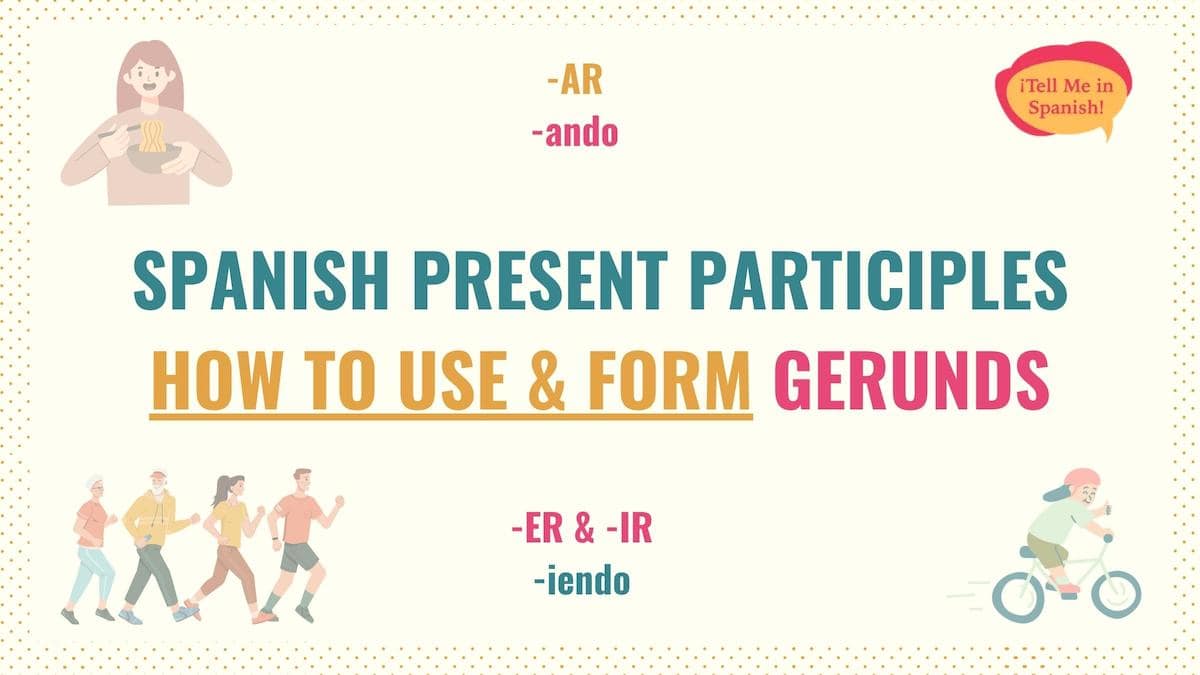The present participle in Spanish is key to talking about ongoing actions. In other words, we use the present participle, also called gerund, to form progressive tenses and communicate that an action is occurring at the moment of speaking or it is still happening.
Since Spanish gerunds can help you improve your command of the language, in this guide, you’ll learn how to use and form these words. Here is a quick overview of the things we’ll cover:
- Conjugating Present Participles in Spanish
- Using Present Participles
- When Not to Use Gerunds in Spanish
- Key Points
- Downloadable PDF
Let’s get to it!
How to Form the Present Participle in Spanish
Spanish present participles have two regular endings:
In other words, to form present participles in Spanish, you must drop the infinitive ending of the verb (-ar, -er, -ir) and add the corresponding gerund ending.
Check these present participles examples:
| Type of Verb | Infinitive Verb | Spanish Present Participle | English |
|---|---|---|---|
| -AR | Hablar | Hablando | Talking |
| -ER | Hacer | Haciendo | Doing |
| -IR | Escribir | Escribiendo | Writing |
Take a second look at the previous examples. When removing their infinitive ending, the stems of these verbs end with a consonant.
However, certain verbs have a stem that ends in a vowel. With these verbs, you must use the present participle ending -yendo to keep the pronunciation consistent. Here are some examples of verbs that use this ending:
- Leer: leyendo
- Construir: construyendo
- Oír: oyendo
- Caer: cayendo
- Traer: trayendo
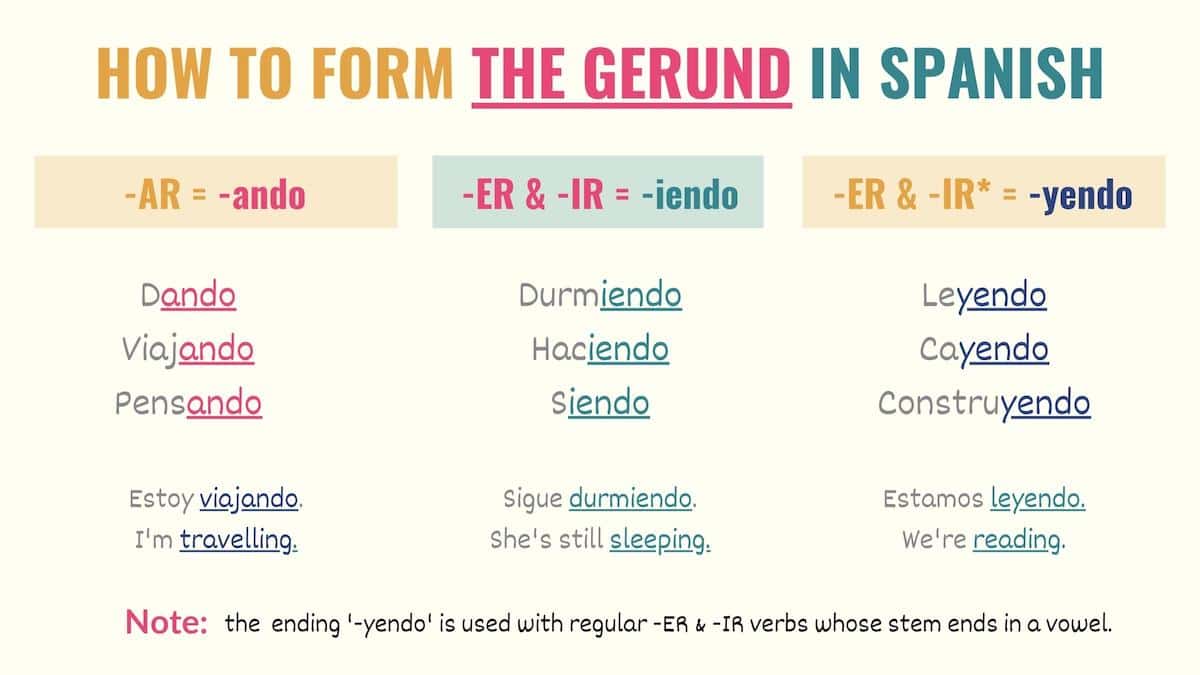
Take Note: Spanish gerunds are the equivalent of English verbs ending in -ing. In some cases, English -ing verbs might be translated as a Spanish infinitive. To learn more about this, check the section on when not to use gerunds.
Irregular gerunds and stem-changes
In Spanish, irregular present participles are verbs which have significant changes, such as:
- Poder – pudiendo
- Ir – yendo
When it comes to gerunds, it’s more common to see stem-changing verbs than irregular verbs. With these verb forms, there are two types of stem changes and they only affect certain -IR verbs.
Type #1: O to U
- Morir: Muriendo
- Dormir: Durmiendo
Type #2: E to I
| Infinitive Verb | Spanish Present Participle |
|---|---|
| Advertir | Advirtiendo |
| Competir | Compitiendo |
| Conseguir | Consiguiendo |
| Consentir | Consintiendo |
| Convertir | Convirtiendo |
| Decir | Diciendo |
| Doler | Doliendo |
| Hervir | Hirviendo |
| Mentir | Mintiendo |
| Reír | Riendo |
| Repetir | Repitiendo |
| Seguir | Siguiendo |
| Sentir | Sintiendo |
| Sugerir | Sugiriendo |
Gerunds with reflexive and direct object pronouns
In Spanish, gerunds often work with a reflexive or direct object pronoun. When this happens, you need to make sure that you place the pronoun in the correct position. Reflexive and object pronouns can be placed in two different positions when working with present participles. Both options are equally correct:
- Before the conjugated verb
Me estoy peinando.
I’m doing my hair.
¿Le estás marcando?
Are you calling her?
- Attached to the gerund
Estoy peinándome.
I’m doing my hair.
¿Está marcándole?
Are you calling her?
When attaching the pronoun, we’re changing the stress of the syllable. As a result, we must add an accent mark. In this case, your endings will look like -ándo or -iéndo. For example: ‘hablándole’, ‘mintiéndole’, ‘diciéndole’, etc.
How & When to Use Spanish Present Participle Verbs
Now that you’ve learned how to form the present participle in Spanish, it’s time to learn how and when to use it.
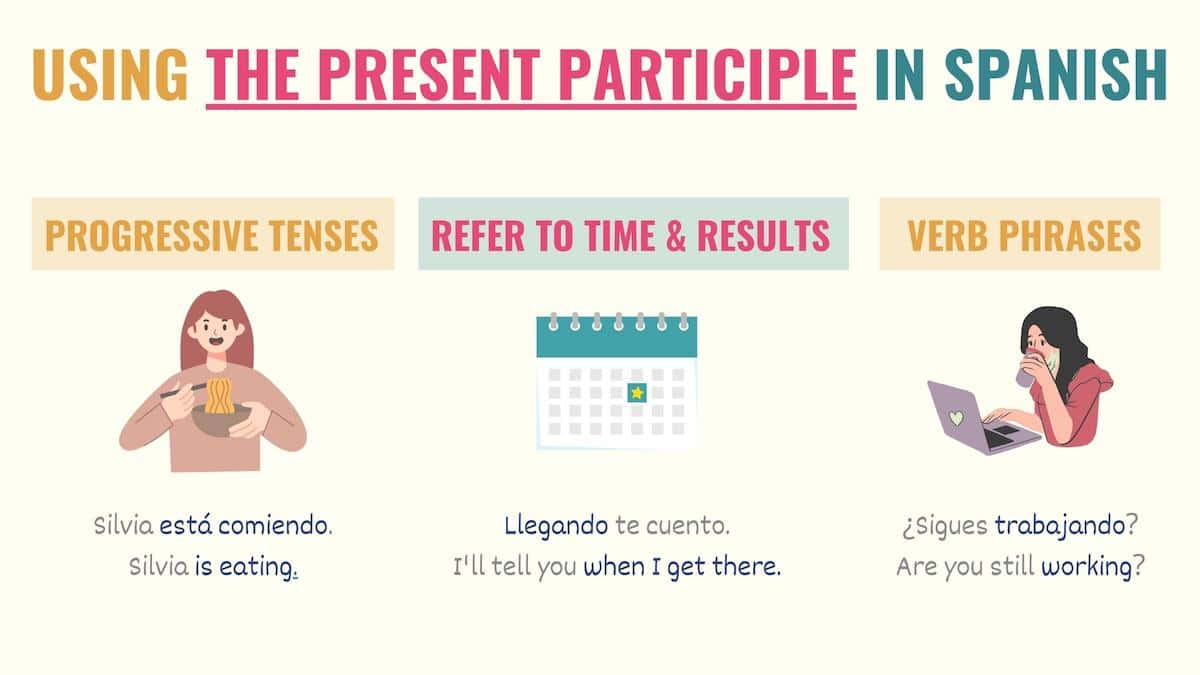
Form present progressive tenses
Gerunds in Spanish are commonly used in the structure estar + gerund. This is the formula for progressive tenses, which refer to actions that happen at the time of speaking.
[Estar conjugated] + [present participle]
Estoy comiendo chocolate.
I’m eating chocolate.
Laura estuvo limpiando toda la noche.
Laura was cleaning all night.
Take Note: Do not mix present and past participles. Present participles are used to build progressive tenses and do not have gender. On the other hand, past participles work as adjectives or to form perfect tenses.
Express time or consequences
When working alone, gerunds can express consequences or convey the time an action takes place. Since these are advanced uses, the translation may vary. Here are some examples:
Llegando te digo.
I’ll tell you when I arrive.
Juan vendió todos sus productos, superando sus objetivos de venta.
Juan sold all of his products, exceeding his sales target.
Forming verbal phrases with present participles
Estar + gerund is probably the verb phrase most Spanish learners know. However, there are other popular structures with present participles that you should know:
- Seguir + gerund: conveys that an action which started in the past is still happening.
- Llevar + gerund: expresses the amount of time someone has been doing something.
- Ir + gerund: communicates that an action is gradually developing.
Yo sigo trabajando aquí.
I’m still working here.
Letty lleva dos años viviendo aquí.
Letty has been living here for two years.
Espérame, ya voy llegando.
Just wait, I’m getting there.
Take Note: Spanish gerunds are impersonal verbal forms. This means that gerunds only focus on delivering information about the action rather than who performed it (subject) or when it occurred (tense).
When Not to Use Gerunds in Spanish
For the most part, present participles work similarly to English gerunds (-ing verbs). However, there are some situations where you cannot use Spanish present participles, and instead, you must use a verb in its infinitive form:
When working as nouns
Correr es bueno para la salud.
Running is good for your health.
After a preposition
Me interesa aprender español.
I’m interested in learning Spanish.
To talk about the immediate future
Voy a volver mañana.
I’m coming back tomorrow.
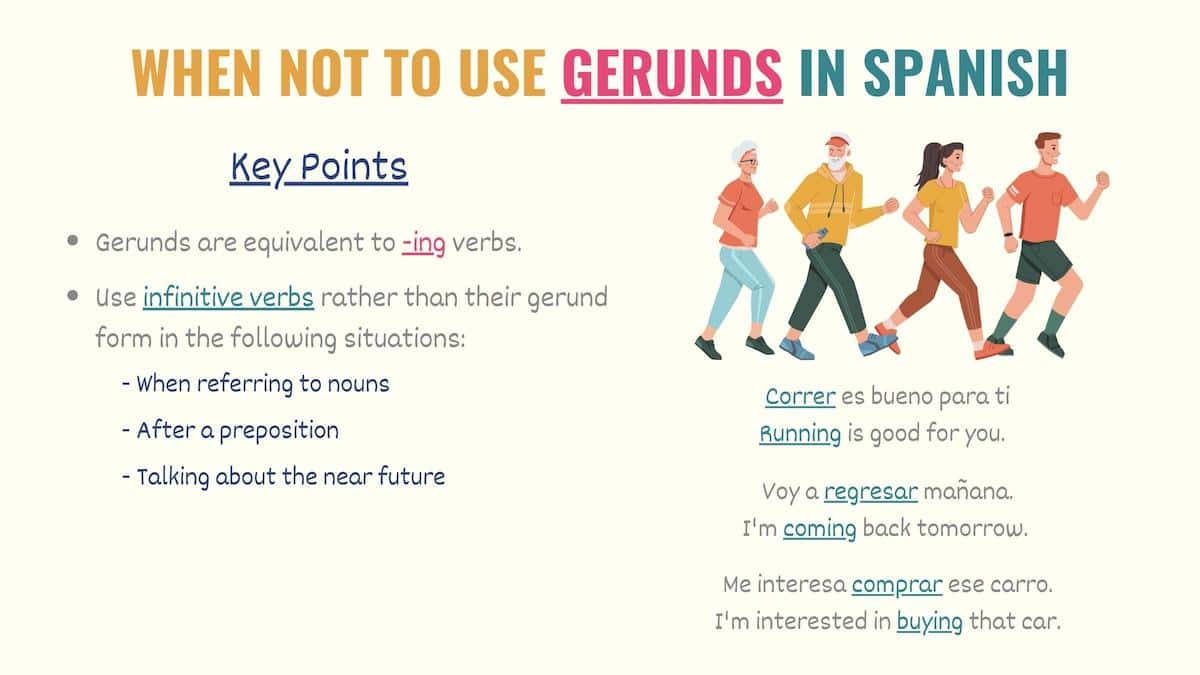
Key Points
Present participles in Spanish are a crucial part of your communication. So, here are some key points you should never forget:
- Regular Spanish present participles are formed with the endings:
- For the most part, Spanish gerunds are the equivalent of -ing verbs in English. However, gerunds in Spanish are never used:
- As nouns
- To talk about future actions
- After a preposition
- Reflexive and direct object pronouns (DOPs) can be placed before the conjugated verb or attached to the gerund.
- Gerunds in Spanish are used to:
- Form progressive tenses
- Express consequences or provide temporary context
- Form verb phrases
Practice Quiz: Spanish Gerunds
If you’re ready to practice Spanish gerunds, take a quiz with these present participle exercises:
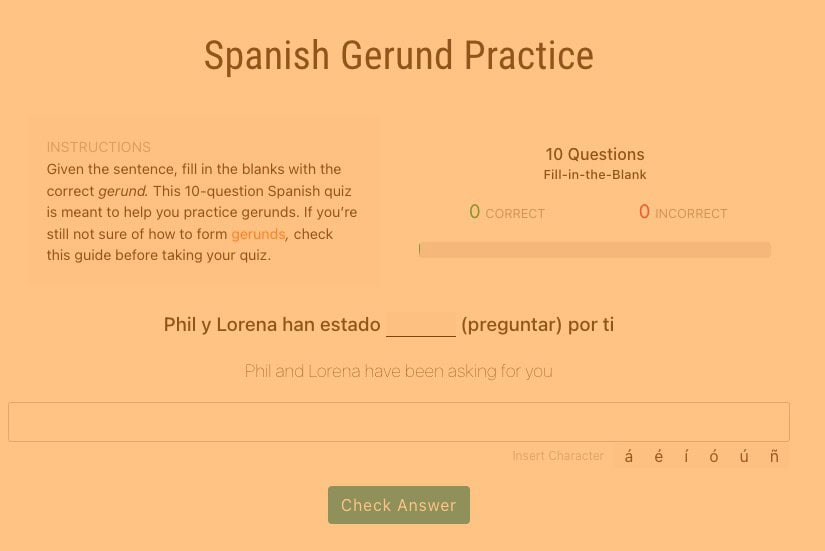
Download the Spanish Present Participle cheat sheets PDF
You can download a PDF copy of the cheat sheets for this guide to refresh your knowledge of the Spanish gerund form when you need it.

